Abstract
2-Bromo-4′-methylpropiophenone is a representative of the haloketone class. 2-Bromo-4′-methylpropiophenone, also known as bromoketone-4, is a precursor for the synthesis of mephedrone. This article provides a comprehensive overview of 2-Bromo-4′-methylpropiophenone, including its general information, physico-chemical properties, chemical information, synthesis methods, concluding remarks, and bibliography.
General Information About 2-Bromo-4′-methylpropiophenone [1-6]
Other synonyms names of 2-Bromo-4′-methylpropiophenone are: 2-Bromo-1-(p-tolyl)propan-1-one; 2-bromo-1-(4-methylphenyl)propan-1-one; 1-Propanone, 2-bromo-1-(4-methylphenyl)-; 2-bromo-1-(4-methylphenyl)-1-Propanone; 1-(4-methylphenyl)-1-oxo-2-bromopropane; 2-bromo-1-p-tolylpropan-1-one; 2-Bromo-p-methylpropiophenone; 4-Methylphenyl 1-bromoethyl ketone.
IUPAC Name of 2-Bromo-4′-methylpropiophenone: 2-bromo-1-(4-methylphenyl)propan-1-one
CAS number is 1451-82-7
Trade names are Bromoketone-4
Different analogs of Bromoketones. This Analogs of Bromoketones are presented on Figure 1.
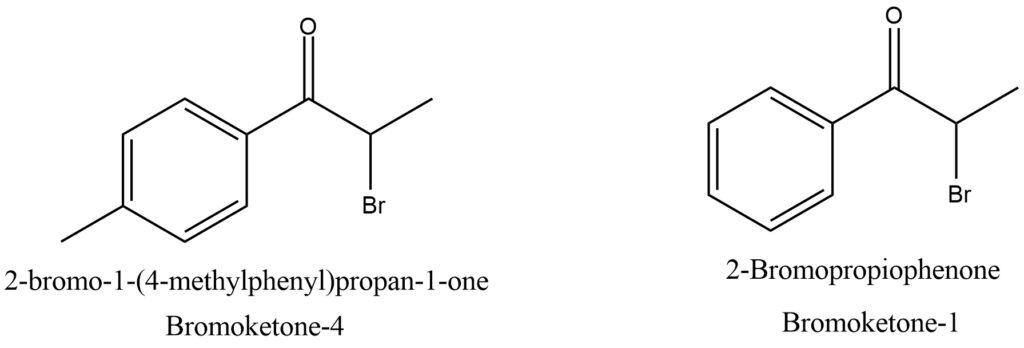
Figure 1. Analogs of Bromoketones
Physico-Chemical Properties of 2-Bromo-4′-methylpropiophenone [1-6]
- Molecular Formula C10H11BrO
- Molar Weight 227.10 g/mol
- Boiling point 274.57 ℃
- Melting Point 54.82 ℃ and 75 ℃ in Biosynth data
- Index of Refraction 1.552
- Solubility: Water Solubility 89.6 mg/L at 25 ℃
- Color/Form: solid
Structural formula present on Figure 2.

Figure 2. Structure of 2-bromo-1-(4-methylphenyl)propan-1-one
Powder and crystalline solid possible of the 2-Bromo-4′-methylpropiophenone can be seen in the picture provided in Figure 3.
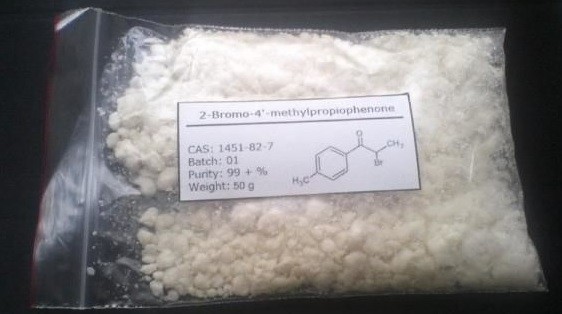
Commercial package of 2-Bromo-4′-methylpropiophenone can be seen in the picture provided in Figure 4.

Chemical Information of 2-Bromo-4′-methylpropiophenone [6-8]
2-Bromo-4′-methylpropiophenone possesses a bromine atom at position 2 and a methyl group (CH3) at the 4′-position on the aromatic ring. Derivatives of propiophenone are widely utilized in organic synthesis and can serve as precursors in the synthesis of various organic compounds. 2-Bromo-4′-methylpropiophenone is a chemical compound belonging to the phenol group. It is employed as a solvent in silicone rubber and functions as a colorant in plastics, paints, and enamels. Additionally, 2-Bromo-4′-methylpropiophenone has demonstrated effective antioxidant properties for china, silica gel, and silicone rubber. When heated, this compound produces a red color and can be used as a connector or monochrome panel on copper plates. Remarkably, this chemical has shown the ability to generate high-efficiency solar modules by converting sunlight into electricity [6].
Chemical reactions
The Favorskii rearrangement is a chemical reaction that involves the rearrangement of carbonyl compounds with α-halo groups, typically in the presence of a strong base. The reaction leads to the migration of the α-halo group to a new position in the molecule, resulting in the formation of a different compound. The Favorskii rearrangement finds broad applications in organic synthesis as a method to form complex molecules with altered carbon frameworks. It can be used to introduce new functional groups or create strained ring systems. The reaction proceeds via a carbanion intermediate, which undergoes rearrangement to form the final product. One example of the Favorskii rearrangement is the transformation of α-bromo ketones into α-carbonyl carbanions, followed by rearrangement to yield carboxylic acids or their derivatives. This reaction has been widely employed in the synthesis of natural products, pharmaceuticals, and other valuable compounds. It’s worth noting that the Favorskii rearrangement requires careful control of reaction conditions, as the reaction can be highly sensitive to the choice of base, temperature, and reaction time. Optimization of these parameters is crucial to achieve the desired product with high selectivity and yield. Overall, the Favorskii rearrangement is a powerful tool in organic synthesis, offering a versatile strategy for the construction of diverse chemical structures and enabling the creation of new compounds with useful properties. Figure 5.
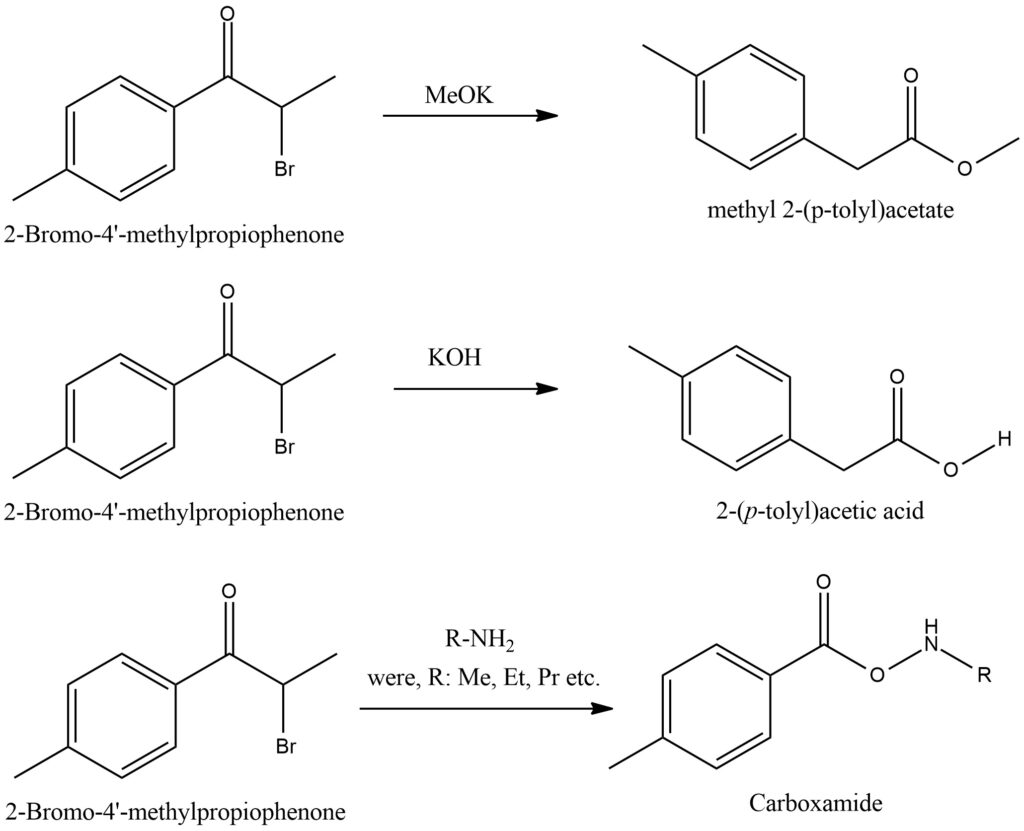
The substitution of one halogen with another in aromatic haloketones is known as halogen exchange. This chemical transformation involves the replacement of a halogen atom, such as bromine or chlorine, with a different halogen atom, such as iodine or fluorine, on the aromatic ring of a haloketone. Halogen exchange reactions in aromatic haloketones can be carried out using various methods, such as nucleophilic substitution or metal-halogen exchange reactions. These reactions are often facilitated by the presence of a suitable reagent or catalyst, which promotes the desired halogen exchange. Halogen exchange reactions in aromatic haloketones can lead to the synthesis of novel compounds with altered halogen substitution patterns. This can have a significant impact on the chemical and physical properties of the resulting compounds, including their reactivity, stability, and biological activity. It is important to note that the specific reaction conditions and choice of reagents or catalysts may vary depending on the desired halogen exchange and the nature of the starting haloketone. Optimization of reaction parameters is necessary to achieve the desired substitution pattern efficiently and selectively. Halogen exchange reactions in aromatic haloketones are widely utilized in organic synthesis and pharmaceutical research. Figure 6.

The Perkow reaction, also known as Perkow synthesis, is a chemical reaction that involves the transformation of a ketone and a trivalent phosphorus organic compound. In the Perkow reaction, the ketone reacts with a trivalent phosphorus organic compound, such as allyl phosphine or phenyl phosphine, in the presence of an acid or base. The reaction proceeds through the formation of a central intermediate complex, in which phosphorus forms a bond with the carbonyl oxygen of the ketone. Electron redistribution then occurs, resulting in the formation of a new bond between the carbonyl oxygen and phosphorus. The Perkow reaction can lead to the formation of various heterocyclic compounds depending on the structure of the ketone and the trivalent phosphorus organic compound used. Figure 7.
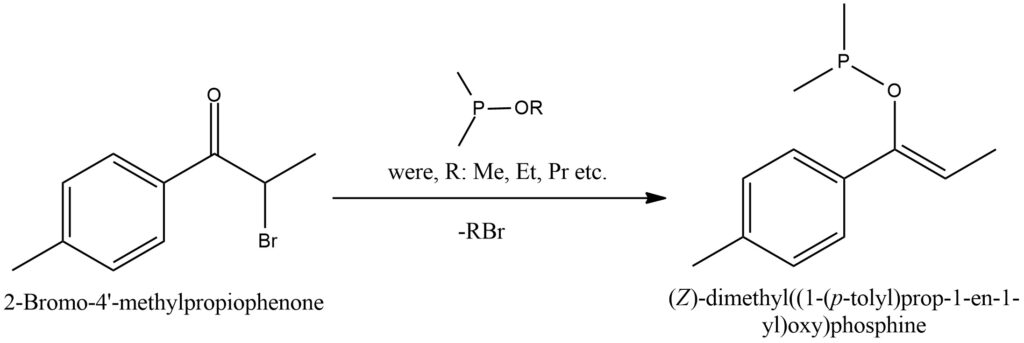
Darzen condensation, also known as Darzen glycidic ester condensation, is a chemical reaction that involves the condensation of an α,β-unsaturated acid chloride or anhydride with an alkoxide or phenoxide nucleophile. This reaction was discovered by the Swiss chemist Victor Darzen in the early 20th century. In the Darzen condensation, the acid chloride or anhydride reacts with the nucleophile, resulting in the formation of a β-hydroxy ester or β-hydroxy ketone. The reaction proceeds through the attack of the nucleophile on the electrophilic carbonyl carbon of the acid chloride or anhydride, followed by elimination of a chloride ion or anhydride molecule. This leads to the formation of a cyclic intermediate, which subsequently undergoes intramolecular nucleophilic attack by the alkoxide or phenoxide group, resulting in the formation of the desired β-hydroxy ester or β-hydroxy ketone. The Darzen condensation is a versatile method for the synthesis of β-hydroxy esters and β-hydroxy ketones. These compounds are important building blocks in organic synthesis and can be further transformed into a variety of functional groups. The reaction can be carried out under mild conditions and offers good control over regioselectivity and stereochemistry. Figure 8.

Ketone hydrogenation, also known as ketone reduction, is a chemical reaction that involves the addition of hydrogen (H2) to a ketone functional group, resulting in the formation of an alcohol. This reaction is widely used in organic synthesis and is commonly catalyzed by transition metal catalysts such as palladium, platinum, or nickel. In ketone hydrogenation, the ketone molecule undergoes a reduction process in the presence of a hydrogen source and a suitable catalyst. The hydrogen is typically supplied as molecular hydrogen (H2) gas, and the catalyst facilitates the activation of the hydrogen and its addition across the ketone carbonyl group. This results in the conversion of the ketone into a corresponding alcohol, with the introduction of a new hydrogen atom. Ketone hydrogenation is a versatile and valuable transformation in organic chemistry, as it allows for the selective reduction of ketones to alcohols, while leaving other functional groups in the molecule intact. The reaction conditions, including temperature, pressure, catalyst, and solvent, can be adjusted to control the selectivity and stereochemistry of the hydrogenation process. Hydrogenation of ketones is used in various applications, including the synthesis of pharmaceuticals, fine chemicals, and natural product derivatives. It enables the conversion of carbonyl groups into more versatile and functional alcohol moieties, which can be further manipulated in subsequent chemical transformations. It’s important to note that ketone hydrogenation is typically carried out under controlled conditions to ensure the desired regioselectivity and avoid over-reduction. The choice of catalyst and reaction parameters should be carefully considered based on the specific ketone substrate and desired product. Figure 9.

Ketones react with hydroxylamine to form ketoximes, releasing water in the process. This reaction, known as ketoximation, involves the addition of hydroxylamine (NH2OH) to the carbonyl group of the ketone, resulting in the formation of a C=N bond and the conversion of the carbonyl oxygen into a hydroxyl group. During ketoximation, the lone pair of electrons on the nitrogen atom of hydroxylamine attacks the electrophilic carbon atom of the ketone’s carbonyl group. This leads to the formation of an intermediate, in which the oxygen of the carbonyl group is bonded to the nitrogen atom. Subsequently, water is eliminated from the intermediate, generating the ketoxime product. Ketoximes are characterized by the presence of the C=N bond, which imparts unique chemical properties to these compounds. They can serve as versatile intermediates in various organic transformations, such as the synthesis of amides, oximes, and other functional groups. Figure 10.

When ketones react with hydrazine, the formation of either hydrazones or azines occurs depending on the reaction conditions. The ratio of hydrazine to ketone determines the product outcome, with a 1:1 ratio resulting in hydrazones and a 1:2 ratio leading to azines. In the case of hydrazone formation, one molecule of hydrazine reacts with one molecule of the ketone. The nitrogen atoms of the hydrazine attack the carbonyl carbon of the ketone, resulting in the formation of a C=N double bond and the conversion of the carbonyl oxygen into a hydrazone group. On the other hand, azine formation occurs when two molecules of hydrazine react with one molecule of the ketone. In this scenario, both nitrogen atoms of the hydrazine participate in the reaction, leading to the formation of a C=N double bond in the ketone and the conversion of the carbonyl oxygen into an azine group. Figure 11.
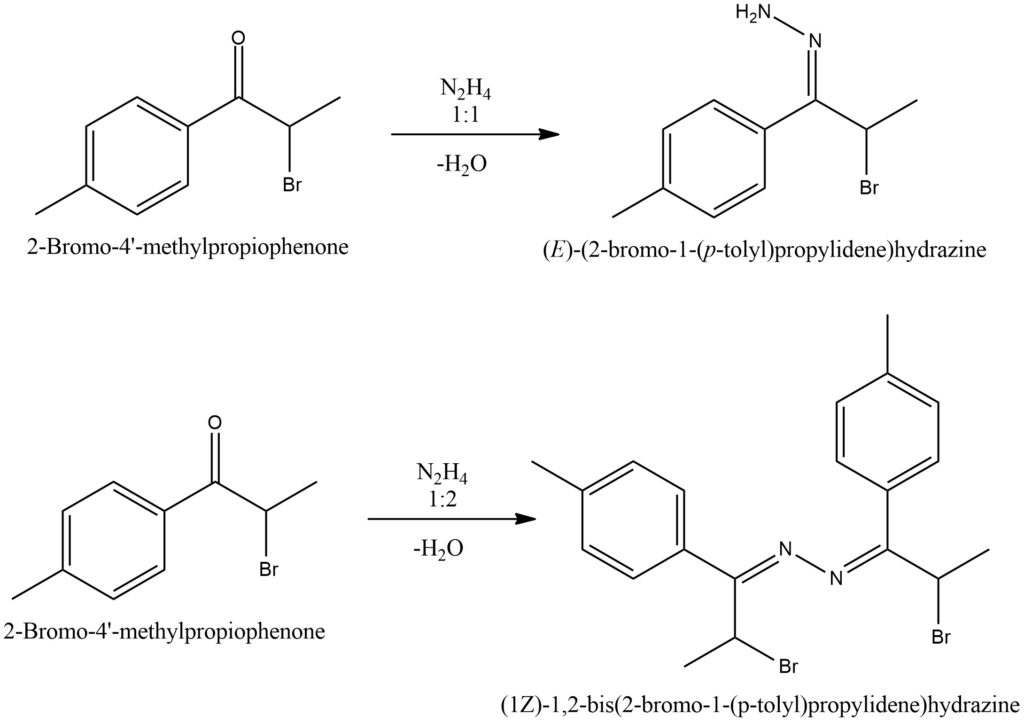
The Leuckart-Wallach reaction is a chemical transformation that involves the conversion of a carbonyl compound, such as a ketone or aldehyde, into an amine. This reaction is commonly used for the synthesis of primary and secondary amines. In the Leuckart-Wallach reaction, the carbonyl compound reacts with formic acid (HCOOH) and an amine, typically ammonium formate (NH4HCO2), under elevated temperatures. The reaction proceeds through a series of steps, including the formation of an imine intermediate, followed by reduction and rearrangement processes. Ultimately, the carbonyl group is converted into an amine group. The reaction conditions, such as temperature, reaction time, and choice of catalyst, can influence the selectivity and efficiency of the Leuckart-Wallach reaction. The use of suitable catalysts, such as Raney nickel or platinum on carbon, is often employed to enhance the reaction rate and yield. Figure 12.

Mephedrone Synthesis Figure 13.

mephedrone synthesis
Synthesis of 2-Bromo-4′-methylpropiophenone [8, 9]
The synthesis of 2-Bromo-4′-methylpropiophenone is easily achieved by the simple bromination of 4′-methylpropiophenone with an equivalent amount of bromine, similar to the synthesis of bromopropiophenone. Please refer to Figure 14 for the scheme.

synthesis
It is also worth considering the possibility of further bromination in the presence of excess bromine, as shown in Figure 15.

Figure 15. Further bromination of 4′-methylpropiophenone in the presence of excess bromine.
Conclusion
2-Bromo-4′-methylpropiophenone is a typical representative of the haloketone class, displaying the properties of both halogen-containing compounds and ketones. It is commonly used in organic synthesis and serves as a precursor for the synthesis of mephedrone. It is easily obtained through the bromination of the corresponding 4′-methylpropiophenone. It is commercially available under the name Bromketone-4.
Bibliography
- https://pubchem.ncbi.nlm.nih.gov/compound/2-Bromo-4_-methylpropiophenone
- https://www.sigmaaldrich.com/UA/en/product/aldrich/471607
- https://en.wikipedia.org/wiki/Mephedrone
- https://www.chemspider.com/Chemical-Structure.2015821.html?rid=9c60a7da-1f06-4135-bd31-7c043ae2926e
- https://www.sigmaaldrich.com/CZ/en/product/aldrich/otv000292
- https://www.biosynth.com/p/FB19151/1451-82-7-2-bromo-4-methylpropiophenone
- https://bbgate.com/threads/4-mmc-mephedrone-synthesis-complete-video-tutorial.616/
- https://en.wikipedia.org/wiki/Propiophenone
- https://bbgate.com/threads/2-bromo-4-methylpropiophenone-synthesis-from-4-methylpropiophenone-bromination-in-dcm-or-gaa.210/

